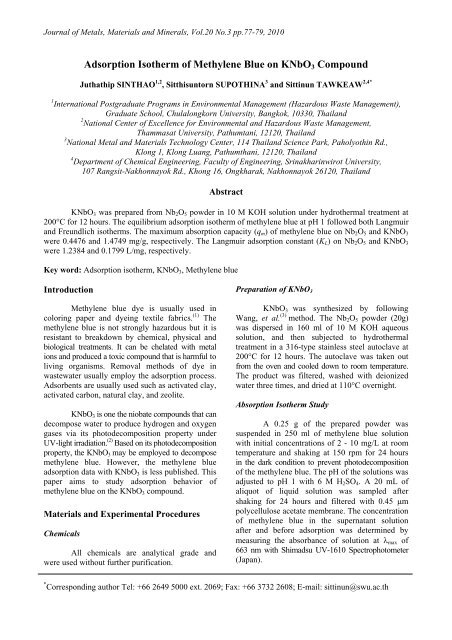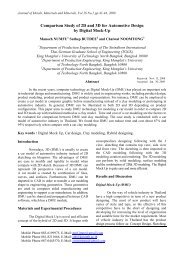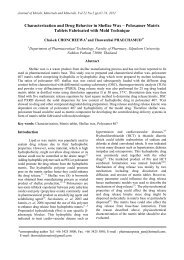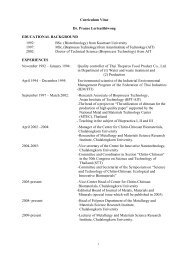Adsorption Isotherm of Methylene Blue on KNbO3 Compound
Adsorption Isotherm of Methylene Blue on KNbO3 Compound
Adsorption Isotherm of Methylene Blue on KNbO3 Compound
Create successful ePaper yourself
Turn your PDF publications into a flip-book with our unique Google optimized e-Paper software.
Journal <str<strong>on</strong>g>of</str<strong>on</strong>g> Metals, Materials and Minerals, Vol.20 No.3 pp.77-79, 2010<br />
<str<strong>on</strong>g>Adsorpti<strong>on</strong></str<strong>on</strong>g> <str<strong>on</strong>g>Isotherm</str<strong>on</strong>g> <str<strong>on</strong>g>of</str<strong>on</strong>g> <str<strong>on</strong>g>Methylene</str<strong>on</strong>g> <str<strong>on</strong>g>Blue</str<strong>on</strong>g> <strong>on</strong> <strong>KNbO3</strong> <strong>Compound</strong><br />
Juthathip SINTHAO 1,2 , Sitthisuntorn SUPOTHINA 3 and Sittinun TAWKEAW 2,4*<br />
1 Internati<strong>on</strong>al Postgraduate Programs in Envir<strong>on</strong>mental Management (Hazardous Waste Management),<br />
Graduate School, Chulal<strong>on</strong>gkorn University, Bangkok, 10330, Thailand<br />
2 Nati<strong>on</strong>al Center <str<strong>on</strong>g>of</str<strong>on</strong>g> Excellence for Envir<strong>on</strong>mental and Hazardous Waste Management,<br />
Thammasat University, Pathumtani, 12120, Thailand<br />
3 Nati<strong>on</strong>al Metal and Materials Technology Center, 114 Thailand Science Park, Paholyothin Rd.,<br />
Kl<strong>on</strong>g 1, Kl<strong>on</strong>g Luang, Pathumthani, 12120, Thailand<br />
4 Department <str<strong>on</strong>g>of</str<strong>on</strong>g> Chemical Engineering, Faculty <str<strong>on</strong>g>of</str<strong>on</strong>g> Engineering, Srinakharinwirot University,<br />
107 Rangsit-Nakh<strong>on</strong>nayok Rd., Kh<strong>on</strong>g 16, Ongkharak, Nakh<strong>on</strong>nayok 26120, Thailand<br />
Abstract<br />
<strong>KNbO3</strong> was prepared from Nb2O5 powder in 10 M KOH soluti<strong>on</strong> under hydrothermal treatment at<br />
200°C for 12 hours. The equilibrium adsorpti<strong>on</strong> isotherm <str<strong>on</strong>g>of</str<strong>on</strong>g> methylene blue at pH 1 followed both Langmuir<br />
and Freundlich isotherms. The maximum absorpti<strong>on</strong> capacity (qm) <str<strong>on</strong>g>of</str<strong>on</strong>g> methylene blue <strong>on</strong> Nb2O5 and <strong>KNbO3</strong><br />
were 0.4476 and 1.4749 mg/g, respectively. The Langmuir adsorpti<strong>on</strong> c<strong>on</strong>stant (KL) <strong>on</strong> Nb2O5 and <strong>KNbO3</strong><br />
were 1.2384 and 0.1799 L/mg, respectively.<br />
Key word: <str<strong>on</strong>g>Adsorpti<strong>on</strong></str<strong>on</strong>g> isotherm, <strong>KNbO3</strong>, <str<strong>on</strong>g>Methylene</str<strong>on</strong>g> blue<br />
Introducti<strong>on</strong><br />
<str<strong>on</strong>g>Methylene</str<strong>on</strong>g> blue dye is usually used in<br />
coloring paper and dyeing textile fabrics. (1) The<br />
methylene blue is not str<strong>on</strong>gly hazardous but it is<br />
resistant to breakdown by chemical, physical and<br />
biological treatments. It can be chelated with metal<br />
i<strong>on</strong>s and produced a toxic compound that is harmful to<br />
living organisms. Removal methods <str<strong>on</strong>g>of</str<strong>on</strong>g> dye in<br />
wastewater usually employ the adsorpti<strong>on</strong> process.<br />
Adsorbents are usually used such as activated clay,<br />
activated carb<strong>on</strong>, natural clay, and zeolite.<br />
<strong>KNbO3</strong> is <strong>on</strong>e the niobate compounds that can<br />
decompose water to produce hydrogen and oxygen<br />
gases via its photodecompositi<strong>on</strong> property under<br />
UV-light irradiati<strong>on</strong>. (2) Based <strong>on</strong> its photodecompositi<strong>on</strong><br />
property, the <strong>KNbO3</strong> may be employed to decompose<br />
methylene blue. However, the methylene blue<br />
adsorpti<strong>on</strong> data with <strong>KNbO3</strong> is less published. This<br />
paper aims to study adsorpti<strong>on</strong> behavior <str<strong>on</strong>g>of</str<strong>on</strong>g><br />
methylene blue <strong>on</strong> the <strong>KNbO3</strong> compound.<br />
Materials and Experimental Procedures<br />
Chemicals<br />
All chemicals are analytical grade and<br />
were used without further purificati<strong>on</strong>.<br />
Preparati<strong>on</strong> <str<strong>on</strong>g>of</str<strong>on</strong>g> <strong>KNbO3</strong><br />
<strong>KNbO3</strong> was synthesized by following<br />
Wang, et al. (3) method. The Nb2O5 powder (20g)<br />
was dispersed in 160 ml <str<strong>on</strong>g>of</str<strong>on</strong>g> 10 M KOH aqueous<br />
soluti<strong>on</strong>, and then subjected to hydrothermal<br />
treatment in a 316-type stainless steel autoclave at<br />
200°C for 12 hours. The autoclave was taken out<br />
from the oven and cooled down to room temperature.<br />
The product was filtered, washed with dei<strong>on</strong>ized<br />
water three times, and dried at 110°C overnight.<br />
Absorpti<strong>on</strong> <str<strong>on</strong>g>Isotherm</str<strong>on</strong>g> Study<br />
A 0.25 g <str<strong>on</strong>g>of</str<strong>on</strong>g> the prepared powder was<br />
suspended in 250 ml <str<strong>on</strong>g>of</str<strong>on</strong>g> methylene blue soluti<strong>on</strong><br />
with initial c<strong>on</strong>centrati<strong>on</strong>s <str<strong>on</strong>g>of</str<strong>on</strong>g> 2 - 10 mg/L at room<br />
temperature and shaking at 150 rpm for 24 hours<br />
in the dark c<strong>on</strong>diti<strong>on</strong> to prevent photodecompositi<strong>on</strong><br />
<str<strong>on</strong>g>of</str<strong>on</strong>g> the methylene blue. The pH <str<strong>on</strong>g>of</str<strong>on</strong>g> the soluti<strong>on</strong>s was<br />
adjusted to pH 1 with 6 M H2SO4. A 20 mL <str<strong>on</strong>g>of</str<strong>on</strong>g><br />
aliquot <str<strong>on</strong>g>of</str<strong>on</strong>g> liquid soluti<strong>on</strong> was sampled after<br />
shaking for 24 hours and filtered with 0.45 μm<br />
polycellulose acetate membrane. The c<strong>on</strong>centrati<strong>on</strong><br />
<str<strong>on</strong>g>of</str<strong>on</strong>g> methylene blue in the supernatant soluti<strong>on</strong><br />
after and before adsorpti<strong>on</strong> was determined by<br />
measuring the absorbance <str<strong>on</strong>g>of</str<strong>on</strong>g> soluti<strong>on</strong> at λmax <str<strong>on</strong>g>of</str<strong>on</strong>g><br />
663 nm with Shimadsu UV-1610 Spectrophotometer<br />
(Japan).<br />
* Corresp<strong>on</strong>ding author Tel: +66 2649 5000 ext. 2069; Fax: +66 3732 2608; E-mail: sittinun@swu.ac.th
78<br />
Analysis<br />
Crystal structure and microstructure <str<strong>on</strong>g>of</str<strong>on</strong>g> the<br />
samples were measured by using an X-ray<br />
diffractometer (XRD, JDX-03530, JEOL, Japan),<br />
and a scanning electr<strong>on</strong> microscope (SEM, JEM-<br />
2010, JEOL, Japan), respectively. Specific surface<br />
area was measured by means <str<strong>on</strong>g>of</str<strong>on</strong>g> nitrogen<br />
adsorpti<strong>on</strong> method (BET, Quantachrome Autosorb<br />
Automated Gas Sorpti<strong>on</strong>).<br />
Results and Discussi<strong>on</strong><br />
Figure 1 shows XRD patterns <str<strong>on</strong>g>of</str<strong>on</strong>g> the starting<br />
powder and the hydrothermal product. The starting<br />
powder showed the XRD pattern corresp<strong>on</strong>ding<br />
to the Nb2O5 phase (JCPDF # 37-1468). The<br />
hydrothermal product showed the XRD pattern<br />
corresp<strong>on</strong>ding to <strong>KNbO3</strong> phase (JCPDF # 71-2171).<br />
Intensity Intensity (a.u.) (a.u)<br />
0 10 20 30 40 50 60 70<br />
Figure 1. XRD patterns <str<strong>on</strong>g>of</str<strong>on</strong>g> the <strong>KNbO3</strong> product and<br />
starting Nb2O5 powder.<br />
Figure 2 shows SEM images <str<strong>on</strong>g>of</str<strong>on</strong>g> the Nb2O5<br />
powder and <strong>KNbO3</strong> product. The Nb2O5 morphology<br />
is a brick-shape particle (Figure 2 (a)). The <strong>KNbO3</strong><br />
product showed the brick-like morphology (Figure 2 (b)),<br />
similar to that reported by Wang, et al. (3) The<br />
specific surface area <str<strong>on</strong>g>of</str<strong>on</strong>g> the <strong>KNbO3</strong> is 4.02 m 2 /g<br />
which is ~ 3 times higher than that <str<strong>on</strong>g>of</str<strong>on</strong>g> the starting<br />
Nb2O5 (Table 1).<br />
Absorbent<br />
2theta (degree)<br />
<strong>KNbO3</strong><br />
Nb2O5<br />
Table 1. <str<strong>on</strong>g>Adsorpti<strong>on</strong></str<strong>on</strong>g> parameters and specific surface area.<br />
SINTHAO, J. et al.<br />
Figure 2. SEM images <str<strong>on</strong>g>of</str<strong>on</strong>g> the <strong>KNbO3</strong> product and<br />
starting Nb2O5 powder.<br />
The equilibrium adsorpti<strong>on</strong> isotherms <str<strong>on</strong>g>of</str<strong>on</strong>g><br />
methylene blue <strong>on</strong>to the adsorbents were determined<br />
by Langmuir and Freundlich isotherms. The Langmuir<br />
equati<strong>on</strong> assumes a finite number <str<strong>on</strong>g>of</str<strong>on</strong>g> coordinati<strong>on</strong><br />
sites <strong>on</strong> the surface <str<strong>on</strong>g>of</str<strong>on</strong>g> an adsorbent, whereas the<br />
Freundlich equati<strong>on</strong> is an empirical equati<strong>on</strong>. (4) The<br />
Langmuir isotherm is expressed as follow. (5)<br />
q<br />
e<br />
qmK<br />
LCe<br />
=<br />
1+<br />
K C<br />
L<br />
e<br />
(1)<br />
where qe is the equilibrium adsorpti<strong>on</strong> capacity<br />
(mg/g), Ce is the equilibrium c<strong>on</strong>centrati<strong>on</strong> <str<strong>on</strong>g>of</str<strong>on</strong>g> the<br />
methylene blue soluti<strong>on</strong> (mg/L), qm is the maximum<br />
capacity <str<strong>on</strong>g>of</str<strong>on</strong>g> methylene blue (mg/g), and KL is the<br />
Langmuir c<strong>on</strong>stant (L/mg).<br />
The Freundlich isotherm is expressed as follow. (5)<br />
q<br />
e<br />
= K C<br />
(2)<br />
F<br />
1/<br />
n<br />
e<br />
where KF is the Freundlich c<strong>on</strong>stant (mg/g (mg/L) n )<br />
and 1/n is the heterogeneity factor.<br />
Langmuir isotherm Freundlich isotherm<br />
R 2 qm (mg/g) KL (L/mg) R 2 n KF (L/mg)<br />
Nb2O5<br />
<strong>KNbO3</strong><br />
BET (m 2 /g)<br />
Nb2O5 0.993 0.4476 1.2384 0.935 5.6180 0.5798 1.33<br />
<strong>KNbO3</strong> 0.914 1.4749 0.1799 0.912 1.6077 0.5428 4.02<br />
3µm<br />
3µm
Figgure<br />
3 showss<br />
the adsorptti<strong>on</strong><br />
isothermm<br />
<str<strong>on</strong>g>of</str<strong>on</strong>g><br />
methylene blue absorbbed<br />
by Nb2OO5<br />
and KNbbO3<br />
absorbents ffollowing<br />
booth<br />
Langmuirr<br />
and Freunddlich<br />
isotherms, rrespectively.<br />
. Both isotheerms<br />
fitted wwith<br />
the adsorptti<strong>on</strong><br />
data. Taable<br />
1 showws<br />
the resultss<br />
<str<strong>on</strong>g>of</str<strong>on</strong>g><br />
the calculaated<br />
isothermm<br />
c<strong>on</strong>stants <str<strong>on</strong>g>of</str<strong>on</strong>g> Nb2O5 and<br />
<strong>KNbO3</strong> forr<br />
methylene blue adsorpti<strong>on</strong>.<br />
The vaalue<br />
<str<strong>on</strong>g>of</str<strong>on</strong>g> n was grreater<br />
than 1 indicating thaat<br />
the methyllene<br />
blue was prreferred<br />
to aadsorb<br />
<strong>on</strong> botth<br />
adsorbentts.<br />
The value o<str<strong>on</strong>g>of</str<strong>on</strong>g><br />
the maximmum<br />
adsorptti<strong>on</strong><br />
capacity<br />
<strong>KNbO3</strong> is hhigher<br />
than the value o<str<strong>on</strong>g>of</str<strong>on</strong>g><br />
Nb2O5 <str<strong>on</strong>g>of</str<strong>on</strong>g><br />
starting maaterial<br />
because<br />
the specific<br />
surface a<br />
<str<strong>on</strong>g>of</str<strong>on</strong>g> <strong>KNbO3</strong> is higher thhan<br />
the valuue<br />
<str<strong>on</strong>g>of</str<strong>on</strong>g> Nb2O5<br />
about 3 timmes.<br />
(4)<br />
y <str<strong>on</strong>g>of</str<strong>on</strong>g><br />
the<br />
area<br />
for<br />
Figure 3. LLangmuir<br />
ploots<br />
(a) and Freundlich pplots<br />
(b) for the addsorpti<strong>on</strong><br />
<str<strong>on</strong>g>of</str<strong>on</strong>g> mmethylene<br />
bluue<br />
at<br />
different initiaal<br />
c<strong>on</strong>centratio<strong>on</strong>s<br />
using Nbb2O5<br />
(�) and KNbbO3<br />
(Δ) adsorbbents.<br />
C<strong>on</strong>clusio<strong>on</strong>s<br />
A<str<strong>on</strong>g>Adsorpti<strong>on</strong></str<strong>on</strong>g><br />
I<str<strong>on</strong>g>Isotherm</str<strong>on</strong>g><br />
<str<strong>on</strong>g>of</str<strong>on</strong>g> M<str<strong>on</strong>g>Methylene</str<strong>on</strong>g><br />
Bl lue <strong>on</strong> KNbO<br />
Thiis<br />
study invvestigated<br />
tthe<br />
equilibriium<br />
adsorpti<strong>on</strong> <str<strong>on</strong>g>of</str<strong>on</strong>g> methyleene<br />
blue <strong>on</strong>nto<br />
Nb2O5 and<br />
<strong>KNbO3</strong> adssorbents.<br />
Thee<br />
methylene blue adsorptti<strong>on</strong><br />
<strong>on</strong> both abbsorbents<br />
folllowed<br />
both Langmuir and<br />
Freundlich isothermss.<br />
Maximuum<br />
adsorptti<strong>on</strong><br />
capacity (qqm)<br />
<str<strong>on</strong>g>of</str<strong>on</strong>g> the K<strong>KNbO3</strong>was<br />
3.3<br />
times higgher<br />
than that <str<strong>on</strong>g>of</str<strong>on</strong>g>f<br />
the Nb2O5.<br />
(a)<br />
(b)<br />
Ac cknowledgeem<strong>on</strong>ts<br />
The auuthors<br />
are ggrateful<br />
to the<br />
Nati<strong>on</strong>al<br />
me etal and Matterials<br />
Technnology<br />
Cent ter (MTEC)<br />
for r financial suupport<br />
<str<strong>on</strong>g>of</str<strong>on</strong>g> thiss<br />
work (MT-B-52-CER-<br />
17- -257-G).<br />
Re eferences<br />
O3 <strong>Compound</strong>d<br />
79<br />
1. Sheng, S J., Xiee,<br />
Y. & Zhou, , Y. (2009). <str<strong>on</strong>g>Adsorpti<strong>on</strong></str<strong>on</strong>g> A <str<strong>on</strong>g>of</str<strong>on</strong>g>f<br />
methyllene<br />
blue ffrom<br />
aqueous<br />
soluti<strong>on</strong>n<br />
<strong>on</strong> pyrrophyllite.<br />
AAppl.<br />
Clay Sci. S 46(4) :<br />
422–4224.<br />
2. Liu, L J. W., Chhen,<br />
G., Li, Z. H. & Zhang, , Z.G. (2007).<br />
Hydrotthermal<br />
syntthesis<br />
and ph hotocatalytic<br />
propertties<br />
<str<strong>on</strong>g>of</str<strong>on</strong>g> ATaaO3<br />
and AN NbO3 (A=Naa<br />
and K) ). Int. J. Hyydrogen<br />
Ener rg. 32(13) :<br />
2269 – 2272.<br />
3. Wang, W Y., YYi,<br />
Z., Li, Y. ., Yang, Q. & Wang, D.<br />
(2007). Hydrothermmal<br />
synthesis <str<strong>on</strong>g>of</str<strong>on</strong>g> o potassiumm<br />
niobatee<br />
powders. CCeram.<br />
Int. 33 3(8) : 1611– –<br />
1615.<br />
4. H<strong>on</strong>g, H H., Jiaang,<br />
W.-T., Zhhang,<br />
X., Tie e, L. & Li, Z.<br />
(2008) . <str<strong>on</strong>g>Adsorpti<strong>on</strong></str<strong>on</strong>g>n<br />
<str<strong>on</strong>g>of</str<strong>on</strong>g> Cr(VI) <strong>on</strong> STACmodifieed<br />
rectorite. AAppl.<br />
Clay Sci. S 42(1-2) :<br />
292–2999.<br />
5. Li, L J., Wang, L., Qi, T., Zhhou,<br />
Y., Liu, C., C Chu, J. &<br />
Zhang, , Y. (2008). Different N-c<strong>on</strong>taining<br />
N<br />
functio<strong>on</strong>al<br />
groups modified mesoporous<br />
adsorbeents<br />
for Cr(VII)<br />
sequestratio <strong>on</strong>: Synthesis,<br />
characterizati<strong>on</strong><br />
andd<br />
comparis<strong>on</strong> n. Micropor.<br />
Mesopoor.<br />
Mat. 1100(2-3)<br />
: 442–4 450.






